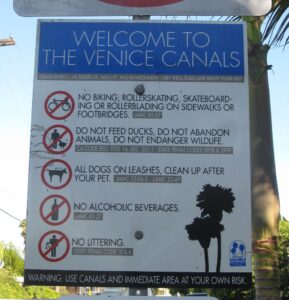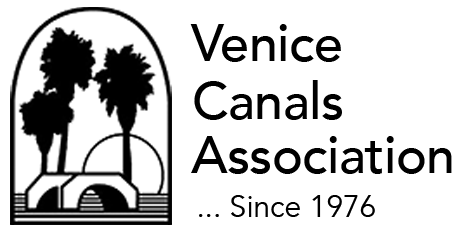FAQs for Visitors
You can visit the Venice Canals year-round without a ticket or reservation. Refer to the information below for guidance on your visit.
“WARNING: USE CANALS AND IMMEDIATE AREA AT YOUR OWN RISK” – City of Los Angeles signs.

By accessing the Venice Canals, you agree to the following terms:
- You acknowledge the risks associated with walking near water and assume full responsibility for your safety.
- The City of Los Angeles, Venice Canals Association, and Venice Canals Foundation are not liable for injuries, accidents, or property damage during your visit.
- You agree to comply with all posted rules and regulations.
- The area may be subject to flooding and other environmental hazards related to sea level rise.
- By using the canals, you release the City of Los Angeles and its affiliates from all claims arising from your visit.
- You are responsible for supervising any minors in your care while using the canals.
- In case of emergency, call 911 immediately.
The Venice Canals were constructed in the early 1900s as part of Abbot Kinney’s Venice in America project. The Venice Canals are a registered Historic District—and a thriving neighborhood of approximately 200 homes and families.The Venice Canals were constructed in the early 1900s as part of the New Amsterdam Canals project (see article Abbott Kinney and his Vision.) The Venice Canal Historic District is listed on the National Register of Historic Places—and thrives as a neighborhood of approximately 350 homes and families.
The Venice Canals are located a few blocks from the Pacific Ocean between Venice Boulevard to the north and Washington Boulevard to the south. Originally, the Venice Canals stretched north to Westminster Avenue and east to Abbot Kinney Boulevard—but a majority of the canals were paved over during the 1920s and 1930s.
The Canals are among the most popular visitor destinations in Los Angeles. You are welcome to visit the Venice Canals without a ticket or reservation. The Venice Canal Association sponsors holiday events year-round, including Canaloween and the iconic July 4th rubber duck race. Canal residents decorate the canal bridges for the Winter Holidays and for Valentine’s Day. You are welcome to take photos and selfies on the Canal bridges and along the Canals.
When you visit, please remember that the Canals are a neighborhood. If you walk your dog on the Canals, please clean up after your pet. Please leave trash in one of the many trash cans along the Canals. Please respect the privacy of residents as you enjoy your walk or run.
Walking to the Canals is easy. There are multiple entrances off Pacific Avenue and Strongs Drive to the west, and along Venice and Washington Boulevards to the north and south. Driving is more challenging. Visitor parking is not available within the Canals. You may find street parking along the perimeter of the Canal District—on Venice and Washington Avenues, Pacific Avenue—or in one of the public parking lots. Visiting the Canals by bicycle is a great choice. However, the sidewalks along the Canals are narrow. Please walk your bike or carry your skateboard, with respect for residents who may be strolling with young children, walking the family dog, or gardening.
You can take a long walk or run along the Canals, or a shorter walk to get a taste. If you want to take in a few of the bridges and walk along a few of the Canals, allow at least 45 minutes.
The diversity of architectural styles of along the Venice Canal reflects the District’s history—and Venice’s artistic spirit. As you walk along the Canals, you will see Venetian villas, Spanish casitas, rambling beach houses, and ultramodern glass structures. Nestled between the contemporary homes, some original one-story bungalows remain, as charming as when they were built in the 1900’s.
The Canals are filled with seawater that comes from the Ballona Lagoon and the Pacific Ocean. When the Canals are full, their depth is approximately 4 feet. The water level in the Canals rises and falls each week, controlled and maintained by the City of Los Angeles. The water level changes based on maintenance, tide conditions, and concerns for flooding in the rainy season. Routine water drainage and refilling occurs at least twice a week, usually on Mondays and Fridays. The maintenance team also empties the canals periodically, to clear the Canals of algae blooms and trash. The water gates are located at the end of the Ballona Lagoon, the Marina Del Rey Channel, and at the corner of Washington Boulevard and Grand Canal.
For your health and safety, we do not advise swimming and fishing in the Venice Canals.
The Venice Canals are a home to a variety of water and sea birds, including herons, egrets, coots, cormorants, seagulls, and many families of Mallard ducks. While the ducks are used to people, and may enjoy eating bread, crackers and other human foods—they are birds. The birds’ natural diet includes small fish, algae, and other small forms of sea life. Feeding the birds human food may affect their digestion and immune systems—and long term, may impact their ability to survive on their own. Though rarely enforced, feeding wildlife is against the law. For all these reasons, we ask that you observe and enjoy the wild birds without feeding them or throwing food trash into the Canals, so that these many species of birds may continue to thrive along the Venice Canals.
The Venice Canals welcome visitors with row or human-propelled boats.
The Venice Canals welcome visitors with row boats, canoes, kayaks, or other human-propelled boats. Motorized boats are not allowed. You may use the public boat launching ramp at 501 North Venice Blvd, between North and South Venice Blvd. In order to protect the saltbush shrubs, wildlife, and wetland vegetation, launching a boat from the public sidewalks is not allowed.
Boats must be a maximum of 18 feet long, or a max of 6 feet wide; the combined length plus width cannot exceed 21 feet. The maximum draft is 2 feet (boat depth in the water),and the maximum height above the water is 3.5 feet.
The Canals are a residential area and are not zoned for commercial activities, including boat rentals.
The Canals are magical early in the morning and at sunset. In the morning, you may see all kinds of sea birds fishing for their breakfast, or resting on the docks and boats. The light on the water is especially beautiful at sunset and in the early evening.
